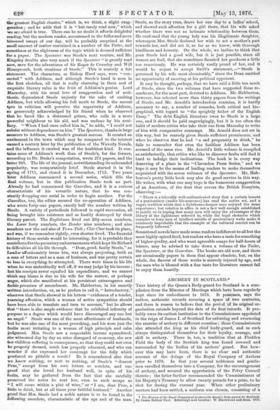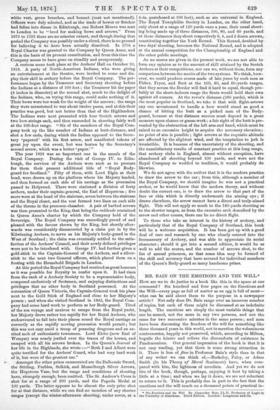ARCHERY IN SCOTLAND.* Tips history of the Queen's Body-guard for
Scotland is a com- pilation from the Minutes of Meetings which have been regularly kept since its embodiment in 1676. It possesses, says the author, authentic records covering a space of two centuries, and there is reason to believe that the period of its original or- ganisation extends beyond the date of its first records. It pro- bably owes its earliest institution to the Commissioners appointed in the reign of James I. of Scotland for enforcing and overseeing the exercise of archery in different counties ; these Commissioners also attended the king as his chief body-guard, and as such always distinguished themselves for their loyalty, courage, and skill in archery. There is, too, a tradition that at Flodden Field the body of the Scottish king was found covered and surrounded by the bodies of his archers' guard. But how- ever this may have been, there is no clear and authentic account of the doings of the Royal Company of Archers prior to 1676. In that year several noblemen and gentle- men enrolled themselves into a Company, for the encouragement of archery, and secured the approbation of the Privy Council thereto ; the latter further recommended the Commissioners of his Majesty's Treasury to allow twenty pounds for a prize, to be shot for during the current year. When other preliminary matters had been settled, a uniform was chosen, consisting of a
* The History of the Royal Company of Archers ((he Queen's Body-guard/or Scotland). By James Balfour Paul. Edinburgh and London : W. Blackwood and Sons. 1876.
white vest, green breeches, and bonnet (coat not mentioned). Officers were duly selected, and as the trade of bower or fletcher had fallen into disuse in Edinburgh, one Robert Monro was sent to London to be "bred for making bows and arrows." From 1679 to 1703 there are no minutes extant, and though during that period the Company was possibly under a cloud, there is no ground for believing it to have been actually dissolved. In 1704 a Royal Charter was granted to the Company by Queen Anne, and this is the basis of its present constitution, and from this time the Company seems to have gone on steadily and prosperously.
A curious scene took place at the Archers' Hall on October 10, 1818. A party of North-American Indians, who were giving an entertainment at the theatre, were invited to come and dis- play their skill in archery before the Royal Company. The per- formance began by the Treasurer and Secretary shooting before the Indians at a distance of 100 feet ; the Treasurer hit the paper (4 inches in diameter) at the second shot, much to the delight of the Indians, who, on trying this range, could make nothing of it. Their bows were too weak for the weight of the arrows ; the range they were accustomed to was about twelve paces, and at this their practice was good, but not better than that of the Highlanders. The Indians were next presented with four Scotch arrows and two bow-strings each, and then succeeded in shooting fairly well at the 100-feet range. "Six of the members of the Royal Com- pany took up the like number of Indians at butt-distance, and shot a few ends, during which the Indian opposed to the Secre- tary 'papered' with his first arrow, and manifested tokens of great joy upon the event, but was beaten by the Secretary's second arrow, which was a better paper."
The year 1824 was an important one in the annals of the Royal Company. During the visit of George IV. to Edin- burgh, the services of the Archers were such as to procure for them their present additional title of "Royal Body- guard for Scotland." Fifty of them, with Lord Elgin at their head, were drawn up on the platform where his Majesty landed, and then formed on each side of his carriage as the procession passed to Holyrood. There were stationed a division of forty archers, under their captain-general, the Earl of Hopetoun ; five more were at the head of the staircase, seven between the staircase and the Royal closet, and the rest formed two lines on each side of the throne in the presence-chamber. A pair of barbed arrows was then presented to the King, that being the reddendo contained in Queen Anne's charter by which the Company held of the Sovereign. The Royal Company was exceedingly proud of and pleased with the favour shown by the King, but shortly after- wards was considerably disconcerted by a claim put in by the Kilwinning Archers, to serve as his Majesty's body-guard in the West of Scotland ; the claim was eventually settled to the satis- faction of the Archers' Council, and their newly defined privileges were not to be interfered with George IV. had farther given a gold-stick to the Captain-General of the Archers, and a silver- stick to the next two General officers, which placed them on a footing with the Household Brigade in London.
At this period the Royal Company had received as great honours as it was possible for Royalty to confer upon it. It had risen from the rank of a Archery Society to be a representative body, composed exclusively of Scotsmen, and enjoying distinctions and privileges that no other body in Scotland possessed. At the coronation of Queen Victoria, the Captain-General took his place next to the Gold Stick of England and close to her Majesty's person ; and when she visited Scotland in 1842, the Royal Com- pany had some hard work to perform as her Body-guard. Tired of the sea voyage and anxious to escape from the Royal yacht, her Majesty drove rather too rapidly for her Royal Archers, who endeavoured to fall into their places round the Royal carriage as correctly as the rapidly moving procession would permit ; but this was not easy amid a troop of prancing dragoons and an ex- cited mob of enthusiastic townsmen. Lord Elcho (now Earl of Wemyss) was nearly jostled over the traces of the horses, and escaped with all his arrows broken. In the Queen's .Tournal of her life in the Highlands, she wrote :—" Both I and Albert were quite terrified for the Archers' Guard, who had very hard work of it, but were of the greatest use."
Amongst the other prizes enumerated are the Dalhousie Sword, the Stirling, Peebles, Selkirk, and Musselburgh Silver Arrows, the Hopetoun Vase, but the range and conditions of shooting have, strangely enough, been omitted. The St. Andrew's Cross is shot for at a range of 200 yards, and the Pagoda Medal at 100 yards. The latter appears to be almost the only prize shot for at that distance, while we can find no mention of any shorter ranges (except the winter-afternoon shooting, under cover, at a 4-in, pasteboard at 100 feet), such as are universal in England. The Royal Toxophilite Society in London, on the other hand, only shoot at a range of 120 yards once a year, their usual shoot- ing being made up of three distances, 100, 80, and 60 yards, and at these distances they shoot respectively 6,4, and 2 dozen arrows, constituting together the York Round. This Round, doubled by two days' shooting, becomes the National Round, and is adopted at the annual competition for the Championship of England and the other public meetings.
As no scores are given in the present work, we are not able to form any opinion as to the amount of skill attained by the Scotch Archers at their competitions, nor can we, without them, form any comparison between the merits of the two systems. We think, how- ever, we could produce scores made of late years by such men as Fisher, Fryer, and Batt at the 100, 80, and 60-yards ranges, that they across the Border will find it hard to equal, though pro- bably-at the short-indoors range the Scots would hold their own against all corners. At the rover's distance (180 yards), which is he most popular in Scotland, we take it that with flight-arrows any one accustomed to handle a bow would stand as good a chance of hitting the butt as a picked man of the Body- guard, because at that distance success must depend in a great measure upon chance or guess-work; a fair sight of the butt is pre- vented by the obstruction of the left arm and hand, which must be raised to an excessive height to acquire the necessary elevation; no point of aim is possible ; light arrows at the requisite altitude are affected by the slightest wind, and the temptation to jerk is irresistible. It is because of the uncertainty of the shooting, and the unsatisfactory results of constant practice at this long range, that archery clubs in England, almost without exception, have abandoned all shooting beyond 100 yards, and were not the- Royal Company so wedded to tradition, it would probably do likewise.
We do not agree with the author that it is the modern practice to draw the arrow to the ear ; from this, although a member of the Royal Company, we should imagine he was not a practical archer, or he would know that the modern theory, and without doubt the correct one, is to draw the arrow to that part of the face or chin which is directly underneath the aiming eye ; if drawn elsewhere, the arrow cannot have a direct and truly-aimed flight. This will not apply so much to the 180-yards shooting as to the shorter ranges, as from the excessive arch described by the arrow and other causes, there can be no direct flight.
To those who take an interest in the history of archery, and particularly that of the Royal Company of Scotland, this book will be a welcome acquisition. It has been got up with a good deal of care and research by one who clearly entered into the freemasonry of Archery, and was able to appreciate its social character ; should it get into a second edition, it would be as well to add the scores, and the number of arrows shot, to the list of annual prizemen, so that some idea may be formed of the skill and accuracy that have secured for individual members of the Queen's Body-guard so many handsome prizes.



































 Previous page
Previous page